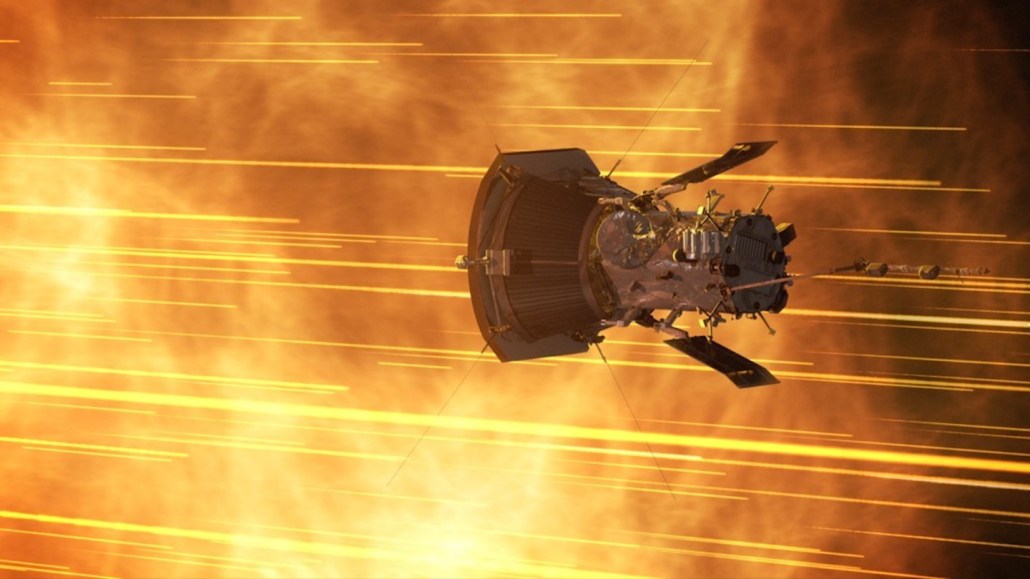
The Parker Solar Probe spacecraft dives into the sun’s atmosphere (illustrated) to study the origins of solar flares and other solar activity.
NASA
- More than 2 years ago
A spacecraft plunging into the sun’s atmosphere has revealed the likely source of powerful blasts of plasma in fast solar winds.
Far from the sun, the solar wind is a nebulous, turbulent plasma. But when NASA’s Parker Solar Probe dipped within about 8 million kilometers of the sun’s surface, it detected narrow plasma streams (SN: 12/15/21). The streams appear to be guided by magnetic fields tracing back to two relatively cool regions of the sun’s atmosphere known as coronal holes, researchers report June 7 in Nature.
The solar wind — the steady stream of charged particles flowing from the sun — has two distinct speeds, dubbed as “slow” and “fast.” Until now, it wasn’t clear what was speeding the fast solar wind along. The plasma in most of the solar wind consists of protons, electrons and the nuclei of atoms blowing at hundreds of kilometers a second. But plasma from the area above the coronal holes can travel more than 10 times as fast.
The fast plasma streams were associated with events known as switchbacks, in which portions of the magnetic fields near the sun reverse direction (SN: 1/15/21). Switchbacks can result when magnetic field loops close to the sun’s surface connect to long field lines extending away from the sun. The reconnection leads to a sharp switchback kink that kicks the plasma on its way into space as the kink straightens out.
Higher energy streams, the researchers propose, are the result of newly reconnected field lines with sharply kinked switchbacks, while lower energy streams come from field lines with older kinks that had become more smoothed out.
Although the evidence that the fast solar wind is due to magnetic reconnections is compelling, it’s still circumstantial, says astrophysicist Stuart Bale of the University of California, Berkeley. “Our results suggest that the solar wind can be accelerated to high speeds very close to the sun,” Bale says. “This is somewhat different [than the] standard scenario of wind energization,” where the acceleration takes place farther from the sun.
Getting a handle on processes like the origin of the fast solar wind is important for practical reasons, Bale says. “We also believe that magnetic reconnection is responsible for solar flares and is involved in the release of coronal mass ejections, which have a major impact in space weather.” Solar flares and the space weather they create have led to electrical grid disruptions on Earth and interrupted radio communications, and they may threaten astronauts (SN: 7/30/2020).
The findings are also an important clue in the enduring mystery of why the sun’s atmosphere is millions of degrees Celsius hotter than its surface, says astrophysicist Gary Zank, who was not involved in the study (SN: 8/20/17). “But they do not identify the heating mechanism.”
The observations identify the importance of magnetic reconnection close to the sun, says Zank, of the University of Alabama in Huntsville. “The next step is to link that to the dissipation of the magnetic energy in determining the actual heating process.”
Another interesting aspect of the study is how the structure of the solar surface seems to be imprinted on the solar wind near the sun despite the presence of turbulence, says Amitava Bhattacharjee, a Princeton University astrophysicist who was not involved with the study. Other researchers have proposed that it can happen, he says, but in the new study, “the experimental and simulation evidence is more convincing.”
Parker’s ever closer encounters with the sun could confirm the source of the fast solar wind more definitively. And future passes will come as the sun heads into a phase with increasing numbers of sunspots and more solar wind, on the way to peak solar activity around July 2025. “As we move into solar maximum,” Bale says, “we expect some serious surprises.”







